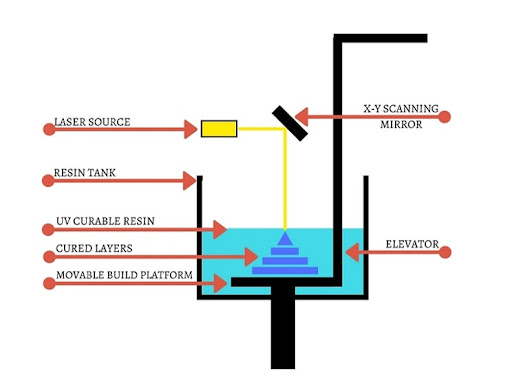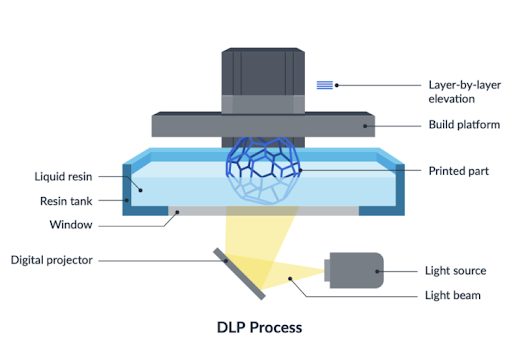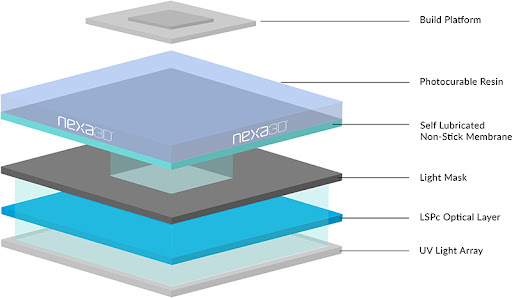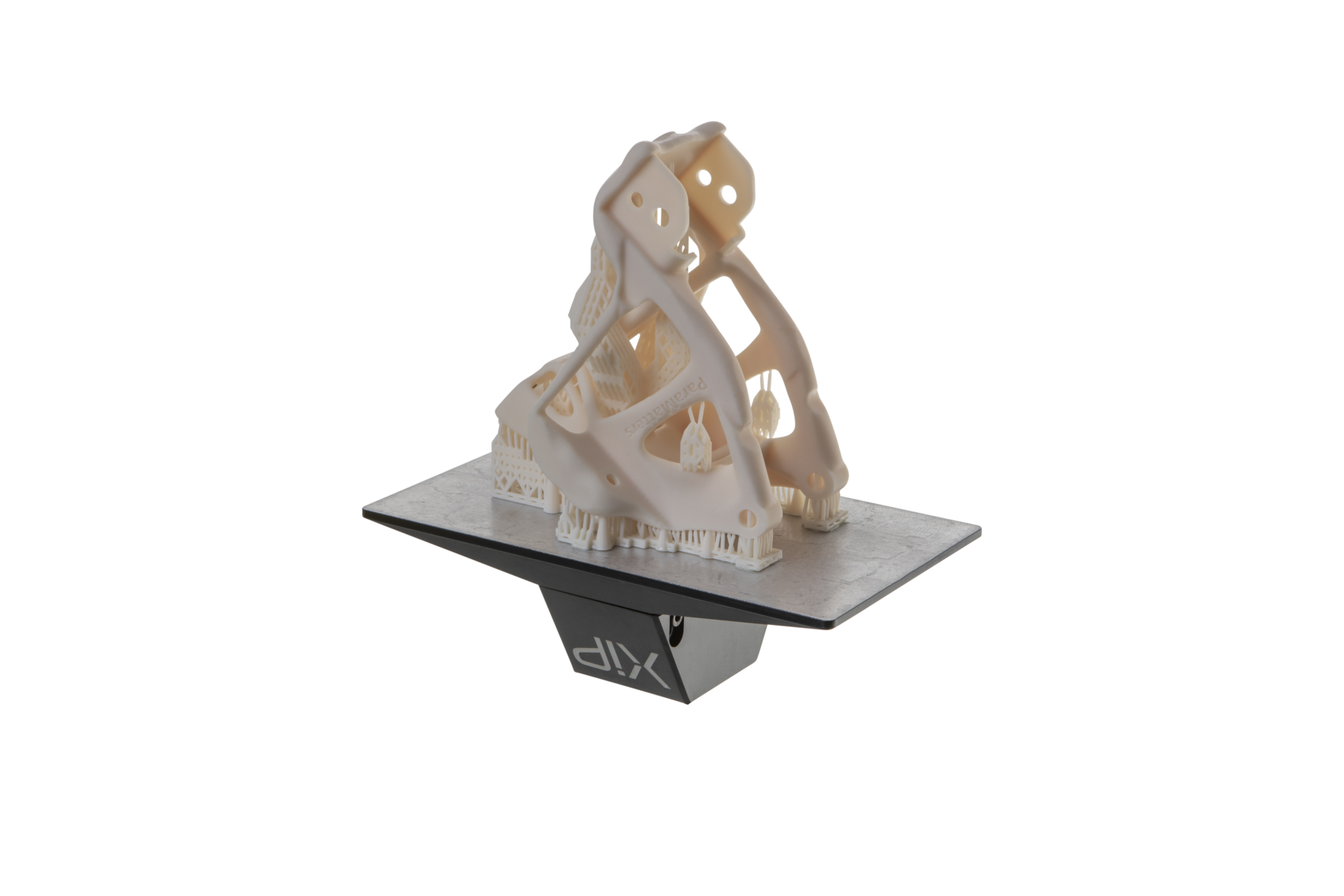- Markforged Onyx Filament Review & Alternatives [2024] - December 11, 2024
- 17 Best Professional 3D Printers: Commercial, Desktop, & Industrial [2024] - December 10, 2024
- Best 3D Printers (Industrial, Desktop, & More) [2024 Guide] - July 20, 2024
Many 3D printer professionals are familiar with using filament-based plastics for 3D printing. But with the advent of resin 3D printers, photopolymer resins have become an incredibly popular 3D printing material. These resins are exposed to light to harden, and they can be used to create very detailed, complex, and accurate shapes.
In this guide to photopolymer resin, we will explore how it works, the different 3D printing technologies using this material, and the benefits and limitations of using photopolymer resins in additive manufacturing.
What is Photopolymer Resin?
Photopolymer resin is a polymer that changes its properties when exposed to light, most commonly ultraviolet light. The light-sensitive substance comprises monomers, oligomers, photoinitiators, and additives.
The photoinitiators are what absorb the light and initiate a reaction that triggers the transformation of the resin. Photopolymers start as liquid resins. The photoinitiators generate free radicals or ions when a UV light source hits the resin. These reactive particles then interact with the monomers and oligomers, leading to a process called photopolymerization.
During photopolymerization, the monomers and oligomers link together in a chemical reaction to form a hardened, solid plastic structure. The rapid and highly controlled transformation process makes it perfect for applications requiring precision and detail, such as 3D printing.
The versatility of photopolymer resins lies in the fact that their properties can be manipulated by adjusting the formulation. Manufacturers can create resins with a wide range of material characteristics by modifying the types and quantities of monomers, oligomers, photoinitiators, and additives. These can include different levels of flexibility, hardness, transparency, color, and resistance to heat or chemicals.
3D Printing Technologies Using Photopolymer Resin
Photopolymer resins are a central component in several resin 3D printing technologies, including Stereolithography (SLA), Digital Light Processing (DLP), and masked SLA (mSLA). In these methods, a light source selectively hardens the resin layer by layer, building up the final 3D object.
1. SLA

Stereolithography (SLA) is one of the oldest and most widely used 3D printing technologies that utilize photopolymer resins. Invented in the 1980s, this process involves a UV laser tracing a pre-programmed design onto the surface of the resin vat. The laser selectively hardens the resin layer by layer to form the final object.
The build platform then moves up or down, exposing the next resin layer to the laser. SLA is known for its high resolution and accuracy, capable of producing parts with fine details and smooth finishes. It’s ideal for creating prototypes, models, and production parts in various industries, including engineering, automotive, and dentistry.
2. DLP

Digital Light Processing (DLP) is another popular method of 3D printing with photopolymer resin. Rather than using a laser to trace the design like in SLA, DLP uses a digital projector screen to simultaneously flash a single image of each layer across the entire platform. This approach allows DLP to be often faster than SLA, as it can cure an entire layer in a single exposure rather than tracing out each part of the design.
However, the resolution of DLP prints can depend on the projector’s pixel size. DLP is suitable for applications requiring speed without compromising the level of detail, such as dental aligners and jewelry casting.
3. mSLA

Masked Stereolithography (mSLA) is a recent addition to the family of 3D printing technologies that use photopolymer resins. Like DLP, mSLA also exposes an entire layer at once, but it does this through a UV LED light source and a liquid crystal display (LCD) mask, which determines where the light hardens the resin.
The LCD mask is updated for each layer, allowing rapid, high-resolution printing. mSLA combines some of the advantages of SLA and DLP, balancing speed, cost, and quality. This technology is useful for producing miniatures, prototypes, and dental models.
Nexa3D’s mSLA technology goes a step further with the patented Lubricant Sublayer Photo-curing (LSPc®), an advanced 3D printing technology that ensures higher quality and smoother surface finishes for resin 3D printing.
The LSPc® combines a UV light array with an LSPc Optical lens layer to ensure light uniformity at ultrafast speeds. Its patented lubricated Everlast 2 membrane also significantly reduces the “peel force” imposed as each layer is lifted off of the base of the vat. This allows for the fastest SLA printing on the market at the largest build area in its class.
Benefits of Using Photopolymer Resin for 3D Printing

Resin 3D printing capabilities with Nexa3D’s XiP.
Superior Print Speed
The best photopolymer resin 3D printers can, when combined with large build volumes, leads to maximum throughput and production yield. High-speed printing processes significantly shorten production cycles, making it possible to deliver functional prototypes and final parts in record time, transforming both economic and production logistics.
Among the fastest 3D printers, like Nexa3D printers, speeds can reach up to 24 vertical centimeters per hour, producing an entire build volume in under two hours. But this exceptional speed does not come at the expense of quality, thanks to a self-lubricating membrane in Lubricant Sublayer Photocuring (LSPc) print technology.
Range of Material Characteristics
Photopolymer resins offer a broad spectrum of material characteristics for specific applications. Adjusting the resin formulation can produce different properties in the final product, including the types and quantities of monomers, oligomers, photoinitiators, and additives. For example, resins can have varying degrees of flexibility, hardness, or transparency while others are heat or chemical resistant, while others can mimic the properties of ceramics or metals.
This versatility means photopolymer resins have various applications, from jewelry and dental models to prototypes and functional parts in multiple industries.
High Accuracy of Complex Geometries
One of the standout features of photopolymer resin 3D printing is its capability to reproduce complex geometries with high precision. The light-based curing process of the resin allows for capturing fine details, making it possible to print intricate designs that would be difficult or impossible to achieve with other manufacturing methods.
This precision is particularly valuable in aerospace, medical, and dental industries, where components often require complex designs and high accuracy. Whether it’s small features on a dental aligner or the detailed design of a prototype, photopolymer resin 3D printing delivers unparalleled precision.
Smooth Surface Finish
Photopolymer resin 3D printing is known for producing prints with a smooth surface finish. This is due to the layer-by-layer curing process, which allows for high control over the print’s surface. The resulting objects often require less post-processing to achieve a smooth finish than other 3D printing methods.
This benefit is crucial in applications where the aesthetics of the final product are essential, such as in product design and consumer products. Additionally, a smooth surface finish can be functionally important, for instance, when producing medical devices or parts that must fit together accurately.
Limitations in Photopolymer Resin 3D Printing
Despite the numerous benefits of using photopolymer resin in 3D printing, there are also certain limitations that users should be aware of.
Some Resins May Be Brittle
While photopolymer resins offer a wide range of material characteristics, some resins can result in brittle products, particularly when printing extremely thin or delicate structures. This brittleness can limit their use in applications that require high durability or impact resistance, such as functional parts in mechanical systems.
Over time, printed parts can also become more brittle due to exposure to light and air, which can cause further material degradation. However, new resin formulations mean more durable and impact-resistant photopolymers always appearing on the market.
Nexa3D resin 3D printers work with a broad range of high-performance materials, ranging from strong and durable resins to elastomeric and modeling materials in addition to an open material platform for maximum flexibility.
Require Some Post-Processing
Post-processing typically involves washing the printed part to remove any uncured resin, followed by a post-curing process to ensure it fully hardens and achieves its final mechanical properties. It can add time and complexity to the production process and requires proper handling and disposal of the used resin and alcohol from the washing process to minimize environmental impact and adhere to safety regulations.
However, the high quality of the final print outweighs the additional post-processing steps. Plus, the advancements in 3D printing technologies are helping to address these challenges. Nexa3D 3D printers streamline the post-processing stage, providing manufacturers with a powerful, consistent, and sustainable post-processing solution.
Use the Best Photopolymer Resin 3D Printers
In the world of 3D printing, the choice of equipment is as crucial as the choice of material. Nexa3D is leading the way in providing superior photopolymer resin 3D printers designed to overcome common challenges and deliver outstanding results.
If you’re considering using photopolymer resin for your 3D printing projects, Nexa3D provides the perfect combination of advanced technology and high-quality materials.
Experience the versatility, durability, and flexibility of photopolymer resin 3D printing.

